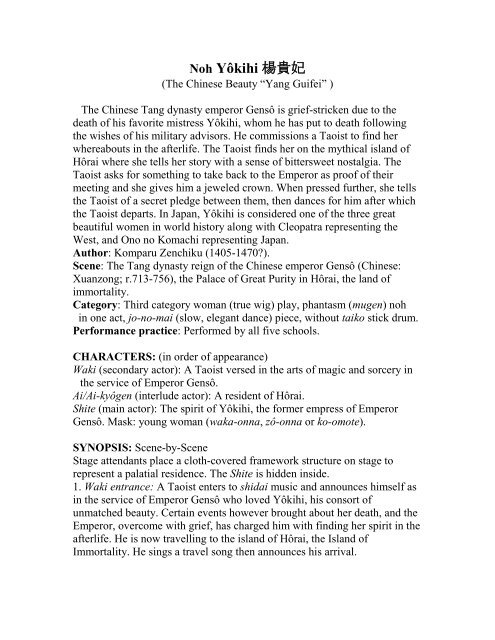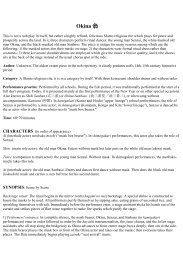Create successful ePaper yourself
Turn your PDF publications into a flip-book with our unique Google optimized e-Paper software.
<strong>Noh</strong> Yôkihi 楊貴妃<br />
(The Chinese Beauty “Yang Guifei” )<br />
The Chinese Tang dynasty emperor Gensô is grief-stricken due to the<br />
death of his favorite mistress Yôkihi, whom he has put to death following<br />
the wishes of his military advisors. He commissions a Taoist to find her<br />
whereabouts in the afterlife. The Taoist finds her on the mythical island of<br />
Hôrai where she tells her story with a sense of bittersweet nostalgia. The<br />
Taoist asks for something to take back to the Emperor as proof of their<br />
meeting and she gives him a jeweled crown. When pressed further, she tells<br />
the Taoist of a secret pledge between them, then dances for him after which<br />
the Taoist departs. In Japan, Yôkihi is considered one of the three great<br />
beautiful women in world history along with Cleopatra representing the<br />
West, and Ono no Komachi representing Japan.<br />
Author: Komparu Zenchiku (1405-1470?).<br />
Scene: The Tang dynasty reign of the Chinese emperor Gensô (Chinese:<br />
Xuanzong; r.713-756), the Palace of Great Purity in Hôrai, the land of<br />
immortality.<br />
Category: Third category woman (true wig) play, phantasm (mugen) noh<br />
in one act, jo-no-mai (slow, elegant dance) piece, without taiko stick drum.<br />
Performance practice: Performed by all five schools.<br />
CHARACTERS: (in order of appearance)<br />
Waki (secondary actor): A Taoist versed in the arts of magic and sorcery in<br />
the service of Emperor Gensô.<br />
Ai/Ai-kyôgen (interlude actor): A resident of Hôrai.<br />
Shite (main actor): The spirit of Yôkihi, the former empress of Emperor<br />
Gensô. Mask: young woman (waka-onna, zô-onna or ko-omote).<br />
SYNOPSIS: Scene-by-Scene<br />
Stage attendants place a cloth-covered framework structure on stage to<br />
represent a palatial residence. The Shite is hidden inside.<br />
1. Waki entrance: A Taoist enters to shidai music and announces himself as<br />
in the service of Emperor Gensô who loved Yôkihi, his consort of<br />
unmatched beauty. Certain events however brought about her death, and the<br />
Emperor, overcome with grief, has charged him with finding her spirit in the<br />
afterlife. He is now travelling to the island of Hôrai, the Island of<br />
Immortality. He sings a travel song then announces his arrival.
2. Waki/Ai exchange: A resident of Hôrai tells him of a woman called the<br />
Jade Princess who deeply yearns for the Chinese court she has left behind.<br />
She lives,he says, in a palace in the woods in the Residence of Great Purity.<br />
3. Waki exclamation: The Taoist tells of going to the palace and remarks on<br />
its magnificence even more splendid then the greatest palaces of China.<br />
4. Shite lament: From inside the covered framework, Yôkihi sings of<br />
viewing the spring blossoms in the gardens of the Chinese palace, the<br />
transience of life, the moonlight, and her tears as she recalls the past.<br />
5. Waki/Shite exchange: The Taoist announces himself and inquires after the<br />
Jade Princess. She describes how she parts the flower curtains and raises the<br />
jeweled blind. Together, they describe her cloud-like hair, her flower-like<br />
face, and her tear-filled eyes. The chorus describes her incomparable<br />
loveliness which surpasses branches of pear blossoms glittering with rain.<br />
6. Waki/Shite exchange: The Taoist tells how distraught the Emperor has<br />
been after her death, and how he has been sent to find her in the afterlife.<br />
Yôkihi sings of the memories which destroy her soul. The Taoist asks for a<br />
keepsake of his visit to take to the Emperor and she gives him a hair jewel,<br />
then reveals a pledge a vow they made to each other to be “in heaven, twin<br />
birds that share a wing, and on earth, twin trees which intertwine.”<br />
7. Shite prelude dance: Yôkihi offers to reenact a dance of long ago. She<br />
retrieves the hair jewel (monogi costume change) and sings that all is but a<br />
play of fantasy and a lonely butterfly dance. She dances an iroe color dance.<br />
8. Shite's narrative dance: With the chorus, Yôkihi refers to the eternal cycle<br />
of birth and death and fate’s wretchedness. The chorus goes on to sing of<br />
how their ties were broken, how sad her present existence is alone, and how<br />
those who meet must also part.<br />
9. Shite's dance: Yôkihi dances the elegant jo-no-mai, described as the dance<br />
of the feather robes.<br />
10. Conclusion: The stage attendants remove the hair jewel which she<br />
returns to the Taoist as he takes his leave. She says how it was all but a<br />
fleeting world of sorrow. The chorus describes her tears as she reenters the<br />
palace. [Richard Emmert]



